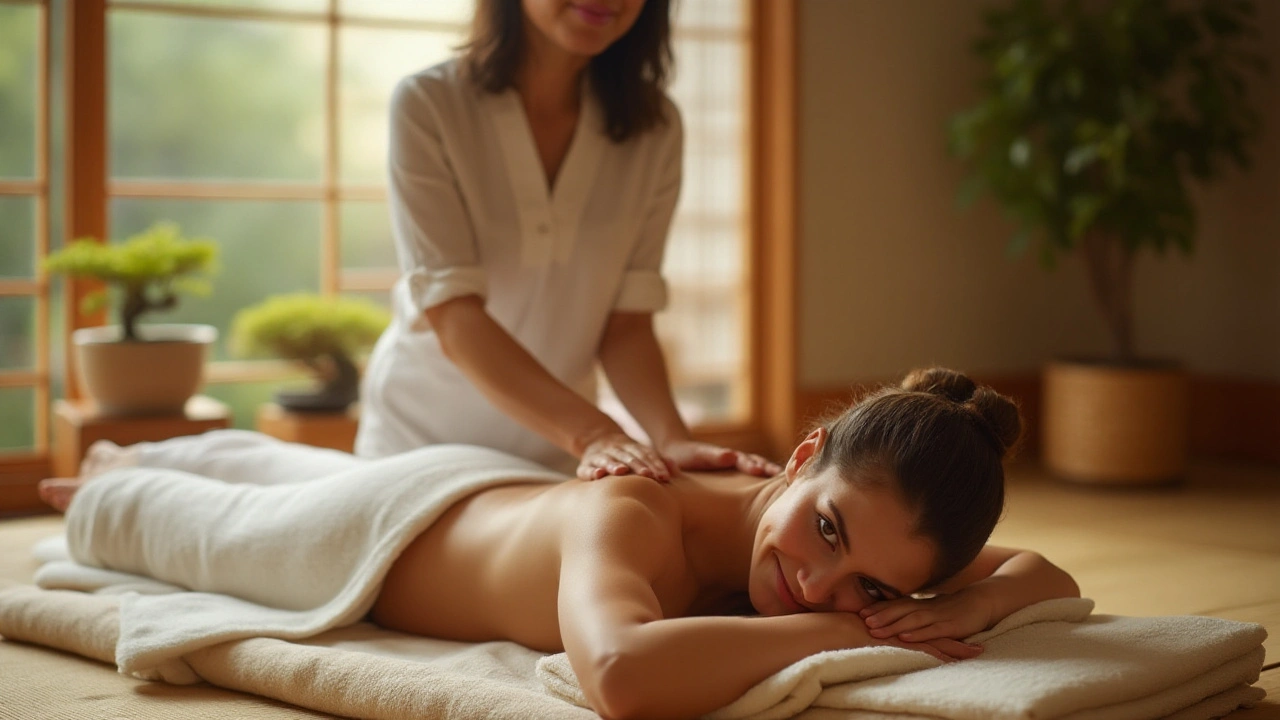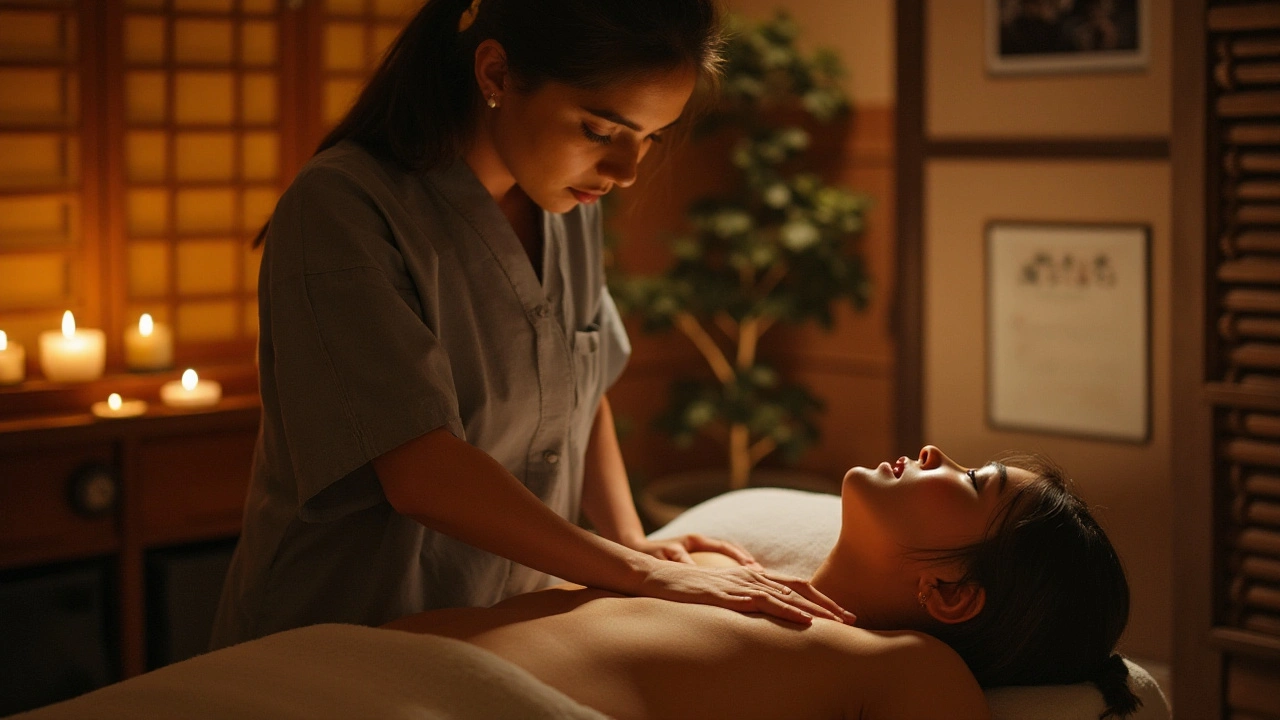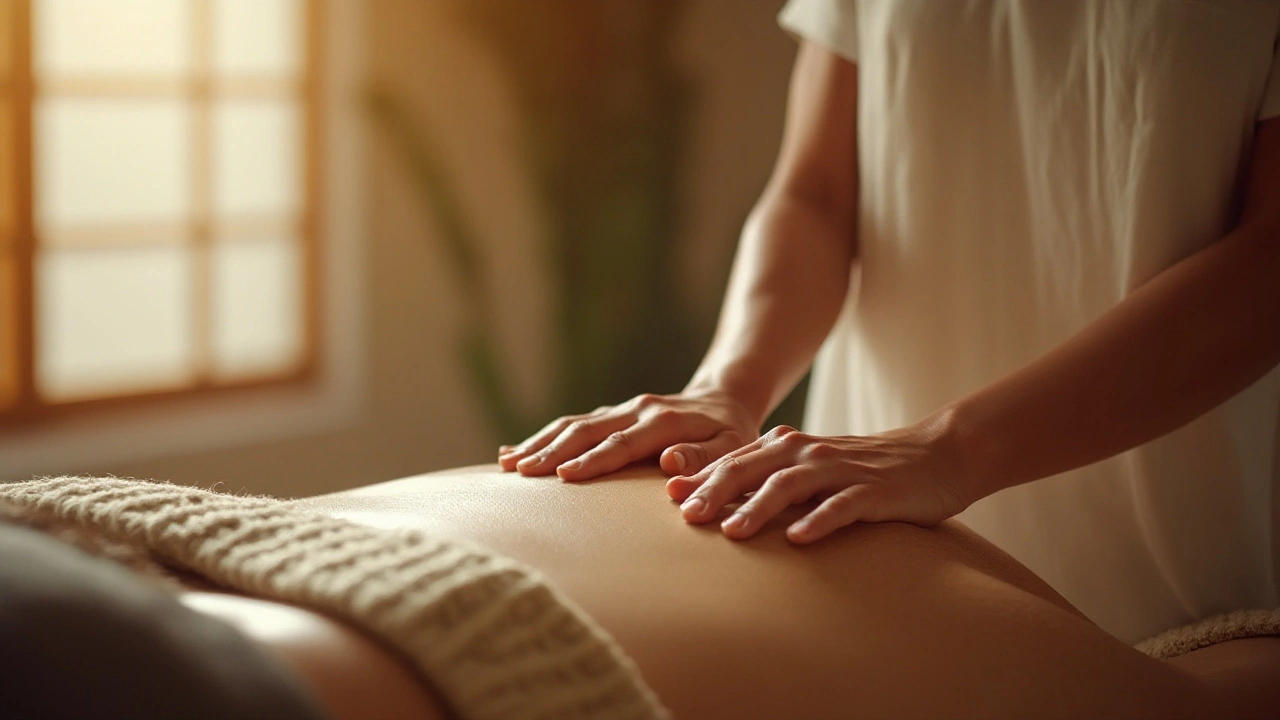Discover the Benefits of Shiatsu Massage Therapy

Many have heard about Shiatsu massage but aren't familiar with its origins or practice. This traditional Japanese therapy involves applying rhythmic pressure to the body, guided by the practitioner’s intuition and expertise.
Rooted in the ancient principles of traditional Chinese medicine, Shiatsu works to restore balance by addressing energy imbalances in the body, known as 'Ki' or 'Qi'. Unlike other types of massage, Shiatsu does not rely on oils or the direct manipulation of muscles but instead on the gentle yet firm pressure applied with the practitioner’s fingers, thumbs, and even elbows in some cases.
By delving into the world of Shiatsu, you open yourself up to a healing journey that not only relaxes but also invigorates and renews the entire body. The subtle art of touch is not just about physical relaxation but also about revitalizing the mind and soul, making it a holistic experience. Let's explore how Shiatsu massage might just be the transformative wellness practice you need.
- The Origins and Philosophy of Shiatsu
- The Unique Techniques of Shiatsu Massage
- Health Benefits and Therapeutic Uses
- Preparing for a Shiatsu Session
- Choosing a Qualified Shiatsu Practitioner
The Origins and Philosophy of Shiatsu
The roots of Shiatsu massage are deeply embedded in the ancient practices of Japan, where the understanding of human anatomy and energy, known as 'Ki', has been pivotal. Shiatsu, which translates to 'finger pressure', draws from a rich history of Eastern medicine that dates back over a thousand years. Despite its historical beginnings, the form of Shiatsu we recognize today began to truly crystallize in the early 20th century, thanks to Tokujiro Namikoshi who developed a more formalized approach.
Shiatsu is in many ways the embodiment of Japanese philosophy where harmony and balance are central. The practice is not merely about applying pressure or treating symptoms piecemeal; it’s a comprehensive system designed to harmonize the body’s energy, enhance natural healing processes, and bring about a renewed sense of well-being. Comparing the body to a flowing river, practitioners view disruptions in this energy flow as the starting point for many health issues. The philosophy hinges on preventing such disruptions and correcting them through meaningful, directed touch.
Central to the philosophy of Shiatsu is the belief that health is a state of blissful energy flow throughout the body. Practitioners are trained to detect the subtle differences in energy—be they blockages or excess—along the meridians and seek to correct these imbalances. This helps not only in providing relief from physical discomfort but is also acclaimed for easing mental tensions. Observers note that this philosophical approach encourages an understanding of the human body as one interconnected entity.
Dr. Shizuto Masunaga, a notable Shiatsu practitioner, once stated, "Shiatsu is like a mother’s love; pressure with the right touch can soothe away pain." This quote beautifully encapsulates the fundamental spirit of Shiatsu therapy.
The growing appeal of Shiatsu worldwide can be credited to this very philosophy: the idea that everyone can reawaken their natural state of balance through pressure and touch. It has since spread far beyond its Japanese roots and is embraced in different cultures for its unique ability to offer therapeutic and holistic benefits without the need for medicines or tools. As we continue to seek wellness in all aspects of life, Shiatsu stands as a testament to the power of gentle yet deliberate touch.
The Unique Techniques of Shiatsu Massage
Shiatsu massage, a hallmark of Japanese culture, boasts a distinct approach that sets it apart from other therapeutic practices. It emphasizes harmony between body and spirit, focusing on the flow of life energy or Qi through designated pathways called meridians. Practitioners of Shiatsu utilize various hand techniques, none more iconic than the use of palms, fingers, and thumbs. This distinctive method allows for precision in pressure application, which is used to identify and alleviate blocks or imbalances within the body's energy meridians.
A key aspect of Shiatsu is its use of holistic principles, addressing the physical body as well as mental well-being simultaneously. Unlike oil-based massages, Shiatsu can be conducted fully clothed, as it doesn't require skin-to-skin contact. This makes it accessible to many who might feel uncomfortable with other styles involving oils or lotions. The massage is performed on a mat or futon on the ground, providing stability and grounding both for the practitioner and recipient. The rhythmic application of pressure is not uniform but rather adjusts to the body's response, encouraging a gentle dialogue of touch and feedback that resonates deep within the person receiving the massage.
The beauty of Shiatsu massage lies in its adaptability; each session is tailored to the individual's needs. The practitioner may employ stretches, joint rotations, and gentle rocking motions to stimulate the energy channels further. These motions not only contribute to physical relaxation but also enhance the mind-body connection, fostering an awareness that extends beyond the session itself. Curious minds often ask about the sensation one might feel during Shiatsu. It's often described as a 'pleasant pressure', akin to a warm, energetic embrace that seems to melt tension away. In some cases, people experience a release of emotions, a testament to the profound mind-body integration that Shiatsu offers.
The techniques used in Shiatsu therapy have been refined over centuries, though modern Shiatsu wasn't formally codified until the 20th century. A pivotal figure in this evolution was Tokujiro Namikoshi, whose development of the method in the early 1900s led to its worldwide recognition. His philosophy emphasized the integration of Western medical knowledge with traditional Eastern practices, bridging a gap that allowed for a broader understanding and respect for Shiatsu in therapeutic communities globally.
"Shiatsu is like an art - a living, creative form that adapts to the life it touches and heals," said Shizuto Masunaga, a crucial figure in spreading Shiatsu in the West.
For those new to Shiatsu or massage therapy, it might be helpful to understand some preparations or expectations before a session. Unlike other styles of massage, Shiatsu doesn't require any special equipment - no oils, creams, or elaborate settings. Instead, the focus is on the connection and the precise, artful application of hand techniques. This simplicity doesn't detract from the effectiveness; many find it amplifies the impact, as the body is encouraged to engage in its healing and balancing process.

Health Benefits and Therapeutic Uses
When it comes to the world of *massage therapy*, Shiatsu massage stands out for its profound impact on physical and mental health. Harnessing the body's intrinsic healing abilities, Shiatsu works to release blocked energy pathways, or meridians, through a nurturing and precise touch. People who regularly receive Shiatsu sessions often report not only feeling physically lighter and less tense but also finding an enhanced emotional well-being. It's a uniquely holistic approach, in which the mind, body, and spirit interconnectedness is a focus, aiming to restore harmony on all levels. Studies have shown that this *massage therapy* can significantly lower stress-related symptoms, such as anxiety and fatigue, by promoting the production of endorphins—the body’s natural mood enhancers.
One of the compelling benefits of Shiatsu is its gentle approach to alleviating chronic pain. Many individuals with conditions such as arthritis, fibromyalgia, and lower back pain turn to Shiatsu for relief. The deep, rhythmic pressure aids in reducing inflammation and enhancing circulation, which, in turn, promotes pain relief and muscle recovery. A study published in the Journal of Alternative and Complementary Medicine highlighted the noticeable reduction in lumbar pain after several weeks of consistent Shiatsu sessions. This evidence supports what practitioners have known for years; Shiatsu nurtures the body’s ability to heal itself without the need for medications.
Shiatsu also excels in boosting the immune system. As a preventive therapy, it aids in maintaining balance in our bodily functions, particularly the lymphatic and circulatory systems. By encouraging lymph flow and removing metabolic waste, Shiatsu can help fend off illnesses by keeping the immune response robust. This is particularly valuable for those who lead a hectic lifestyle and are prone to colds and other infections. Furthermore, regular Shiatsu massages can improve digestion by stimulating the peristaltic movement in the gastrointestinal tract, which helps relieve issues like bloating and constipation. Most clients notice an improvement in sleep quality, too. Shiatsu sessions support the release of melatonin, a hormone that regulates sleep patterns. This can lead to a more restful night, enhancing energy levels and focus during the day.
"Shiatsu therapy harmonizes the flow of energy and induces a deep state of relaxation, which catalyzes the healing process, both physically and emotionally," says renowned practitioner Namiko Kishi in her book on Shiatsu principles.
Moreover, athletes often use Shiatsu to complement their training regimens. They find that it helps in increasing flexibility and range of motion, leading to better performance. By focusing on specific pressure points, Shiatsu targets tight muscles and improves overall joint mobility. This proactive treatment method minimizes the risk of injury and enhances recovery post-exercise, an aspect that avid trainers appreciate greatly.
For many, Shiatsu is not just a *massage therapy* but also a significant part of a self-care regime. People seeking a natural way to reduce stress levels, manage pain, or simply lead a healthier lifestyle often turn to Shiatsu for its myriad benefits. Its therapeutic uses are vast and tailored to meet the unique needs of each individual, making it a personalized answer to common health woes. As understanding of the mind-body connection continues to grow, therapies like Shiatsu solidify their place in the wellness routines of many, emphasizing natural healing and comprehensive care.
Preparing for a Shiatsu Session
As you embark on your journey to experience the benefits of Shiatsu massage, it's essential to know how to prepare to get the most out of your session. These traditional Japanese therapies are profoundly relaxing and healing, but like all good things, a bit of preparation can enhance your experience. One of the first things to consider is what to wear. Unlike some massages where disrobing is required, Shiatsu is typically performed through clothing. Keep this in mind when choosing your attire; opt for loose, comfortable clothes, allowing for easy movement. This ensures that you remain comfortable while the therapist works on achieving the desired pressure and movement without restriction.
Additionally, diet is another aspect to consider. Arriving neither on a full stomach nor too hungry can make a world of difference. A light meal an hour or two before your appointment is advisable. This not only makes you physically comfortable during the therapy but also prevents potential discomfort that a full stomach can cause when pressure is applied. It helps you be more relaxed, and you’ll be able to focus better on how your body responds to the massage, and thus, provides feedback more effectively to your massage therapist.
Hydration is another critical consideration. Drink plenty of water before your session to keep your body well-hydrated. Water helps flush out toxins released during the massage and helps muscles remain flexible and receptive to the applied pressure. Think of it as preparing your body for a thorough internal cleansing process.
Communicating your needs and goals with your therapist cannot be stressed enough. Open dialogue is key to achieving a successful Shiatsu session. Before your session starts, share any particular areas of concern or discomfort with your practitioner. This allows them to tailor their technique to suit your specific health needs and preferences. A good therapist will appreciate knowing whether you’re seeking relaxation, relief from specific aches, or balancing your body’s energy.
It’s also beneficial to ask questions about the process itself if you’re new to Shiatsu. Many people harbor curiosity about the philosophical underpinnings of Shiatsu therapy or the physical sensations they might experience. Asking gives you confidence and helps your therapist understand and respect your level of comfort with the process. Remember, the goal is mutual; your therapist is there to help you discover peace and healing during this sacred time.
"The simplicity and efficiency of Shiatsu massage lie in a skilled practitioner's ability to harmonize with the patient," says respected Shiatsu teacher Tokujiro Namikoshi. "Understanding the practitioner’s role is critical in promoting overall health and wellness."
Lastly, it’s important to manage expectations. Shiatsu works by stimulating the body's own healing processes and can be a powerful tool for well-being, yet it may not be a quick fix for chronic issues all on its own. Consider a series of sessions to allow for a more profound transformation and better results. Embrace the opportunity for healing practices that grow over time, and be patient with your mind and body as they adjust to this new method of self-care.

Choosing a Qualified Shiatsu Practitioner
Deciding on the right Shiatsu massage practitioner is crucial to ensure you get the most out of each session. When searching for a practitioner, begin by checking their credentials and training background. Qualified Shiatsu therapists usually have extensive training, often passed down through traditional educational systems, ensuring they understand both the physical and energetic components of the body. It is beneficial to ask about their certification and if they are registered with any professional bodies, which often require ongoing education.
Experience plays a significant role in the effectiveness of a massage. An experienced practitioner can often sense what areas need more attention and tailor the session accordingly. Therefore, it's worth considering how long they have been practicing and whether they have specific experience related to your personal needs, as each individual might seek Shiatsu for varying reasons, from stress relief to chronic pain management.
Personal Recommendations and Initial Consultations
Word of mouth can be a powerful tool. Ask friends, family, or healthcare providers for recommendations, which can point you toward practitioners known for their skill and professionalism. It’s also worthwhile to read reviews online and see what other clients have to say. Most practitioners offer an initial consultation; use this as an opportunity to discuss your needs, ask any questions, and gauge your comfort level with the therapist. This meeting can also give you a sense of their communication style and dedication to their practice.
"Shiatsu is not just a technique; it's an art of communication through touch, where understanding and empathy are key," says Tomoko Sanda, a renowned Shiatsu therapist.
Location and setting are important factors too. Consider the vibe of the studio or clinic where the sessions will take place. A quiet, serene environment contributes significantly to relaxation. Additionally, ensure that the practitioner maintains high hygiene standards for the safety and wellbeing of clients.
Price is another factor to think about but remember that the cheapest option isn't always the best. Balancing cost with quality is vital. Sometimes, higher fees align with better qualifications and experience venues. You might also inquire about different packages or discounts for multiple sessions, as regular Shiatsu therapy can enhance long-term benefits.
Remember, a Shiatsu massage is more than just a session; it’s a therapeutic partnership. Trust, comfort, and mutual respect between you and your therapist can greatly influence the outcome of the therapy. Choosing wisely makes the journey towards healing smoother and more fulfilling.





